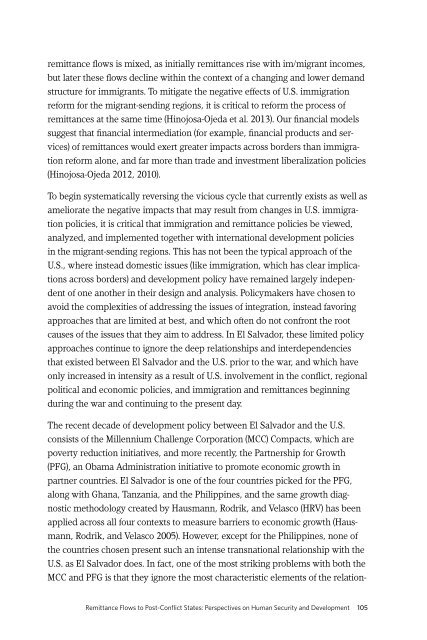Pardee-CFLP-Remittances-TF-Report
Pardee-CFLP-Remittances-TF-Report
Pardee-CFLP-Remittances-TF-Report
Create successful ePaper yourself
Turn your PDF publications into a flip-book with our unique Google optimized e-Paper software.
emittance flows is mixed, as initially remittances rise with im/migrant incomes,but later these flows decline within the context of a changing and lower demandstructure for immigrants. To mitigate the negative effects of U.S. immigrationreform for the migrant-sending regions, it is critical to reform the process ofremittances at the same time (Hinojosa-Ojeda et al. 2013). Our financial modelssuggest that financial intermediation (for example, financial products and services)of remittances would exert greater impacts across borders than immigrationreform alone, and far more than trade and investment liberalization policies(Hinojosa-Ojeda 2012, 2010).To begin systematically reversing the vicious cycle that currently exists as well asameliorate the negative impacts that may result from changes in U.S. immigrationpolicies, it is critical that immigration and remittance policies be viewed,analyzed, and implemented together with international development policiesin the migrant-sending regions. This has not been the typical approach of theU.S., where instead domestic issues (like immigration, which has clear implicationsacross borders) and development policy have remained largely independentof one another in their design and analysis. Policymakers have chosen toavoid the complexities of addressing the issues of integration, instead favoringapproaches that are limited at best, and which often do not confront the rootcauses of the issues that they aim to address. In El Salvador, these limited policyapproaches continue to ignore the deep relationships and interdependenciesthat existed between El Salvador and the U.S. prior to the war, and which haveonly increased in intensity as a result of U.S. involvement in the conflict, regionalpolitical and economic policies, and immigration and remittances beginningduring the war and continuing to the present day.The recent decade of development policy between El Salvador and the U.S.consists of the Millennium Challenge Corporation (MCC) Compacts, which arepoverty reduction initiatives, and more recently, the Partnership for Growth(PFG), an Obama Administration initiative to promote economic growth inpartner countries. El Salvador is one of the four countries picked for the PFG,along with Ghana, Tanzania, and the Philippines, and the same growth diagnosticmethodology created by Hausmann, Rodrik, and Velasco (HRV) has beenapplied across all four contexts to measure barriers to economic growth (Hausmann,Rodrik, and Velasco 2005). However, except for the Philippines, none ofthe countries chosen present such an intense transnational relationship with theU.S. as El Salvador does. In fact, one of the most striking problems with both theMCC and PFG is that they ignore the most characteristic elements of the relation-Remittance Flows to Post-Conflict States: Perspectives on Human Security and Development 105


